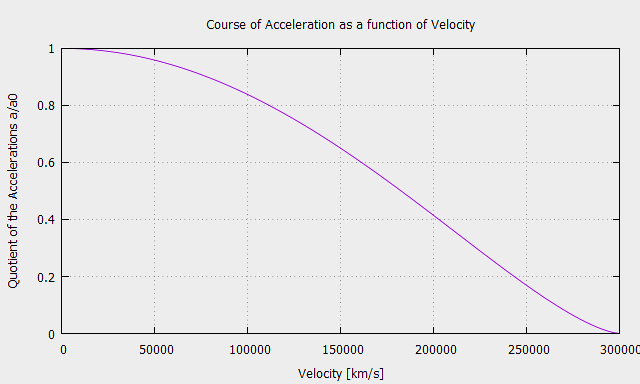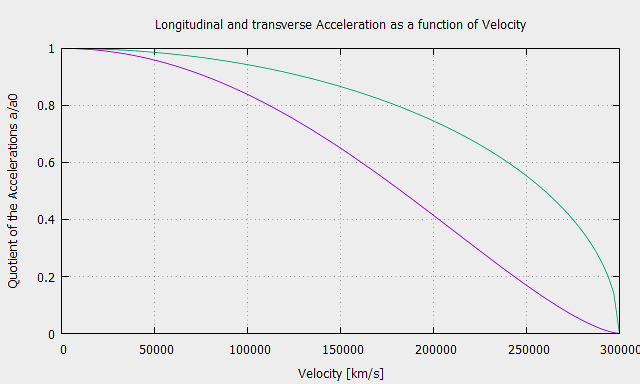An alternative derivation of relativistic acceleration can be made using Newton‘s Second Law of Motion1 with relativistic mass.
(This is an abbreviated version of the alternative derivation of relativistic acceleration. For the full version, click here).
A simple case of proving relativistic acceleration is that of motion in the same direction as the force. In this case it is sufficient to use a procedure based on a scalar calculation.
Proof with scalar calculus
The proof of relativistic acceleration with scalar calculus can be done in two ways:
- Starting from the implicit form F = d (mv)/dt of the Second Law of Motion, by replacing m with the relativistic mass formula (see the calculation procedure).
- Starting from the explicit form F = mdv/dt + vdm/dt of the Second Law of Motion, by replacing m with the relativistic mass formula and dm with the equivalent expression for energy (see the calculation procedure).

In the more general case, which also includes situations where the direction of motion is different from that of the force, it is necessary to perform a demonstration based on a vector calculation.
This gives the longitudinal and transverse components of the relativistic acceleration.
Proof with vector calculus
The proof of relativistic acceleration with vector calculus uses the Second Law of Motion in its most general form.
In this case, Newton’s law is expressed by the following vector relation:
\[ \vec{F}=\frac{d(m\vec{v})}{dt} \quad \Rightarrow \quad \vec{F}=\vec{v}\frac{dm}{dt}+m\frac{d\vec{v}}{dt}\quad\quad (16.1)\]Substituting the relations of equivalence between energy and mass:
\[ \frac{dm}{dt}=\frac{\vec{F}\circ\vec{v}}{c^2}\]and of relativistic mass into equation (16.1):
\[ m = \frac{m_{0}}{\sqrt{1-\frac{v^{2}}{c^{2}}}} \]we obtain the following relationship:
\[\vec{F}=\frac{\vec{F}\circ\vec{v}}{c^2}\vec{v}+\frac{m_{0}}{\sqrt{1-\frac{v^{2}}{c^{2}}}}\frac{d\vec{v}}{dt}\quad\quad (16.8)\]The vector calculation leads to the derivation of the longitudinal and transverse components of the relativistic acceleration:
\[ a_L=\frac{F_L}{m_0}\left(1-\frac{v^{2}}{c^{2}} \right)^\frac{3}{2} \quad ; \quad a_T=\frac{F_T}{m_0}\left(1-\frac{v^{2}}{c^{2}} \right)^\frac{1}{2} \]
This alternative derivation shows that Newton’s second law of motion, even in vector form, is compatible with the theory of relativity.
You can find the detailed version of this alternative derivation of the relativistic acceleration in the sixteenth chapter of the book “Newton and Relativity”.
The Relativistic Calculator allow you to calculate the acceleration ratio a/a0 as a function of speed.
______________
The aim of this website is to introduce the theory of relativity using a new, simple and accessible demonstration method.
To support this project, please order the book “Newton and Relativity“.
______________
Footnotes:
- On this website, we consistently use Newton’s second law of motion in its original form, which states that force is equal to the time derivative of the momentum:
\[\vec{F}=\frac{d(m\vec{v})}{dt}=m\frac{d\vec{v}}{dt}+\vec{v}\frac{dm}{dt}\]
In this form, Newton’s law is also compatible with variable mass as it occurs at relativistic speeds. ↩︎



Leave a Reply